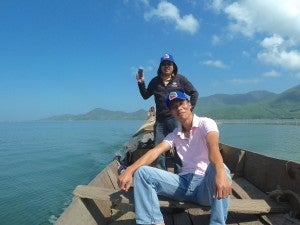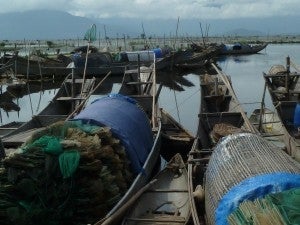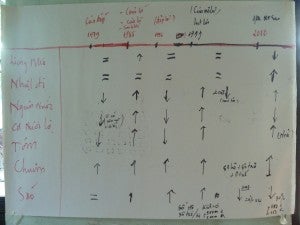The Cau Hai lagoon is the southernmost section of a series of four interconnected lagoons that are more commonly referred to as the Tam Giang lagoon. Over the last few months I have been living in Huế City and doing fieldwork with some excellent people at the Huế University of Agriculture and Forestry (HUAF). Most of my work has been facilitated by Ha and Nam, who are junior faculty at HUAF (in photo below). We work together to refine research tools and they set up interviews and focus groups and provide translations.


Before I delve into some preliminary observations from the field, a few words are needed about my views on social-ecological transformations. I define a transformation as a fundamental reorganization of social-ecological systems that results in a qualitatively different system identity. This definition comes out of resilience thinking and I can point to papers by Cumming and colleagues (2005) and Walker and colleagues (2010) as being particularly influential. The notion of system identity at once acknowledges the subjectivity of deciding if and when a social-ecological transformation has occurred; and offers a level of generality for comprehending complex system interactions (i.e. I don’t want my PhD to last 10 years).
Using this lens enables me to consider the causes and the implications of long-term changes for local people and the ecosystem services they rely on. If the system has a new identity, what does this mean for livelihoods and wellbeing? What are the prospects for transforming into a more sustainable and desirable system identity? I’m not able to fully answer these questions yet, but I have been able to piece together some of the broad strokes of what I see as a transformation in the Cau Hai lagoon.
I hold the perspective that ecosystems do not have a pristine or original state and are co-evolving with human systems. In the case of the Cau Hai lagoon, there is ample oral and written evidence of human activity in and around the lagoon for at least several hundred years. Increasing population density since the early years of the Nguyen dynasty, several wars, and various fishing activities have had their impacts on the lagoon and shaped system dynamics. Nevertheless, in the mid-1980s the lagoon social-ecological system seems to have begun a shift towards a fundamentally different character.

The period since the 1980s has been epitomized by the intensification of fisheries activities and the introduction and rapid expansion of aquaculture around the lagoon. What is noteworthy to me is that I have been able to identify both environmental and socio-economic factors that have contributed to the ongoing transformation. The photo of the timeline above is taken from one of my focus groups where the participants were first asked to identify key system components, which are listed in the left column (this group selected rainfall, temperature, water environment, freshwater fish, shrimp, ‘chuom’ traps, and corral nets). They were then asked to create a long-term timeline with key dates and events. This activity was replicated in 9 focus groups and the resultant discussion about changes to the system components was very illuminating.
Several key dates and events were consistent across all of the focus groups. A large flood in 1999 was particularly important because it blew open the mouth to the South China Sea, making the lagoon brackish once again (the lagoon has historically switched between brackish and freshwaters as the sea mouth opens and closes). Vietnam had initiated economic reforms in 1986 through its doi moi (‘renovation’ or open market) policy that precipitated the introduction of aquaculture in the Cau Hai lagoon around 1991. The 1990s saw limited expansion of aquaculture in the form of net enclosures in open water and building mud wall ponds along the shoreline. From the perspective of fishers, the 1999 flood was significant because it was large enough to flush out the build up of contaminants in the lagoon. With the sea mouth now open, the relatively clean, brackish water environment ushered in an aquaculture boom over the next several years. With high market prices for shrimp (especially tiger and white-legged shrimp), many households converted their assets into aquaculture production to take advantage of new livelihood opportunities. As noted by Tuyen and colleagues (2010) and elsewhere, any viable lagoon space and adjacent land was claimed for aquacultural use.
Interviews with government officials added another layer of important detail. Continuing with open market economic reforms across Vietnam, in 1999 the Thua Thien-Hue Province passed a Land Conversion policy that enabled the conversion of rice fields adjacent to the lagoon to be turned into aquaculture ponds. Thus, while the 1999 flood was a significant turning point (threshold? regime shift?), the rapid expansion and intensification of aquaculture was enabled by a series of policy changes and ideal market conditions.
Success and profits were nearly universal but the aquaculture boom was short-lived and reached a peak by 2003-2004. By this time, disease outbreaks in the monoculture production were high and many households had to abandon their ponds due to lost stock, escalating input costs, and mounting debt. Several local governments around the lagoon have now banned white-legged shrimp in aquaculture ponds and, over the last decade, a form of polyculture (i.e., ponds with a mix of shrimp, crab and fish) became the predominant aquaculture practice in the lagoon. Aquaculture farmers have told me that the profits from polyculture are lower compared to monoculture but they now enjoy more stability and have less risk.
Parallel to the aquaculture expansion, the lagoon also experienced an intensification of fishing activity due to the introduction of new, more efficient gear. A report by Mien in 2006 described roughly 30 types of fishing gear that have been in use in the Tam Giang – Cau Hai lagoon. I will save this story arc for a future blog post and/or manuscript. The brief synopsis is that overfishing has been – and continues to be – a serious problem in the lagoon, as evidenced by dwindling yields and decreasing size of fish, shrimp and crab.



There are some promising signals within this transformation. A co-management network among government agencies and fishers has emerged and has facilitated the implementation of new policies aimed at improving the condition of resources in the lagoon. As the process of transformation continues, questions still remain about the possibility of crossing undesirable ecological thresholds. The remainder of my fieldwork is focused on exploring the possibility that this period of upheaval could lead towards governance arrangements and livelihood activities that have a better fit with ecological conditions.
The material and discussion presented here are not intended for reproduction or citation. Publications forthcoming. Questions or comments can be sent directly to Mark at mandrach@uwaterloo.ca or on Twitter @MarkAndrachuk.
This research is being carried out with the aid of a Doctoral Research Award from the International Development Research Centre (Ottawa, Canada) and a SSHRC doctoral award.